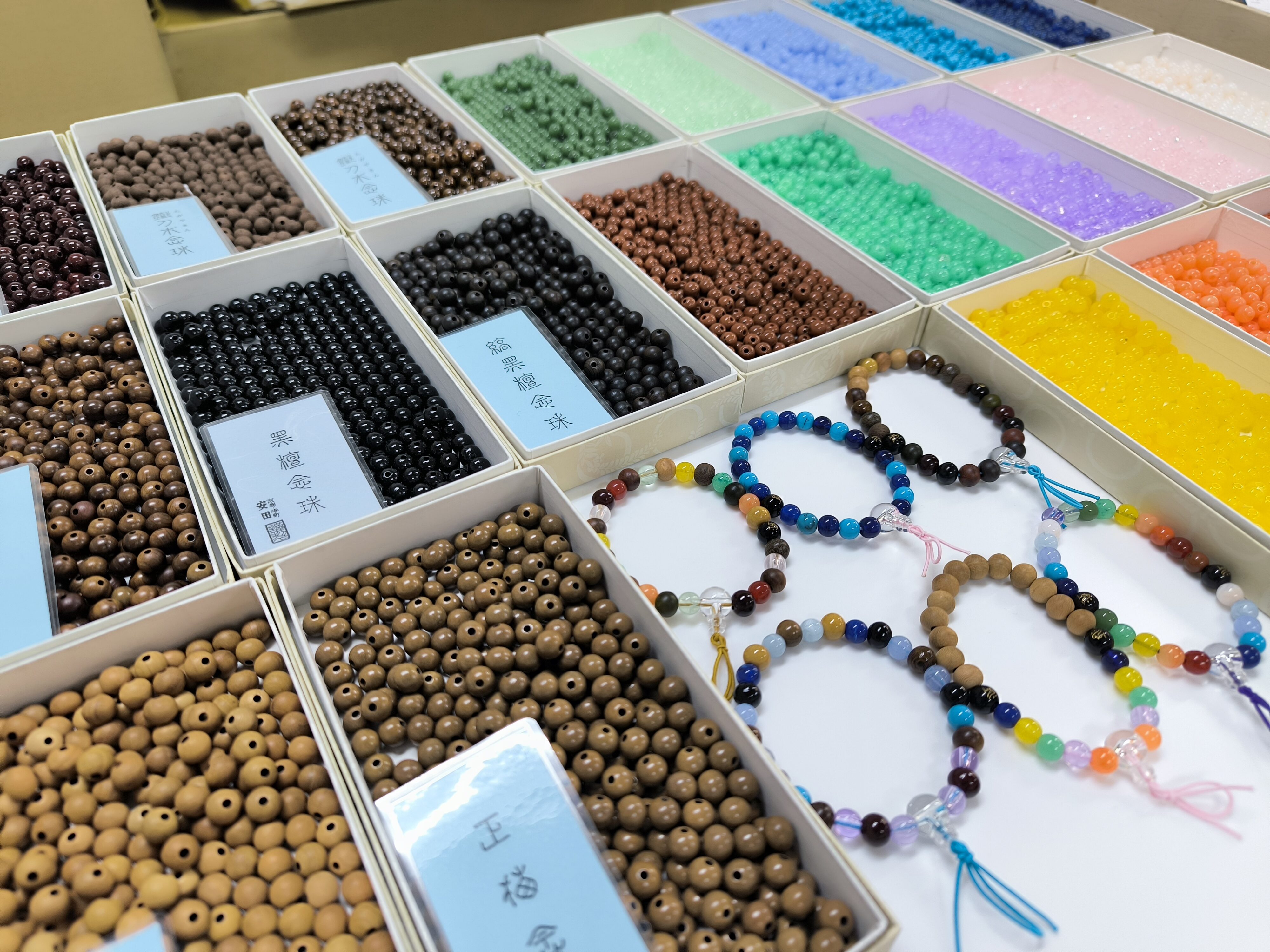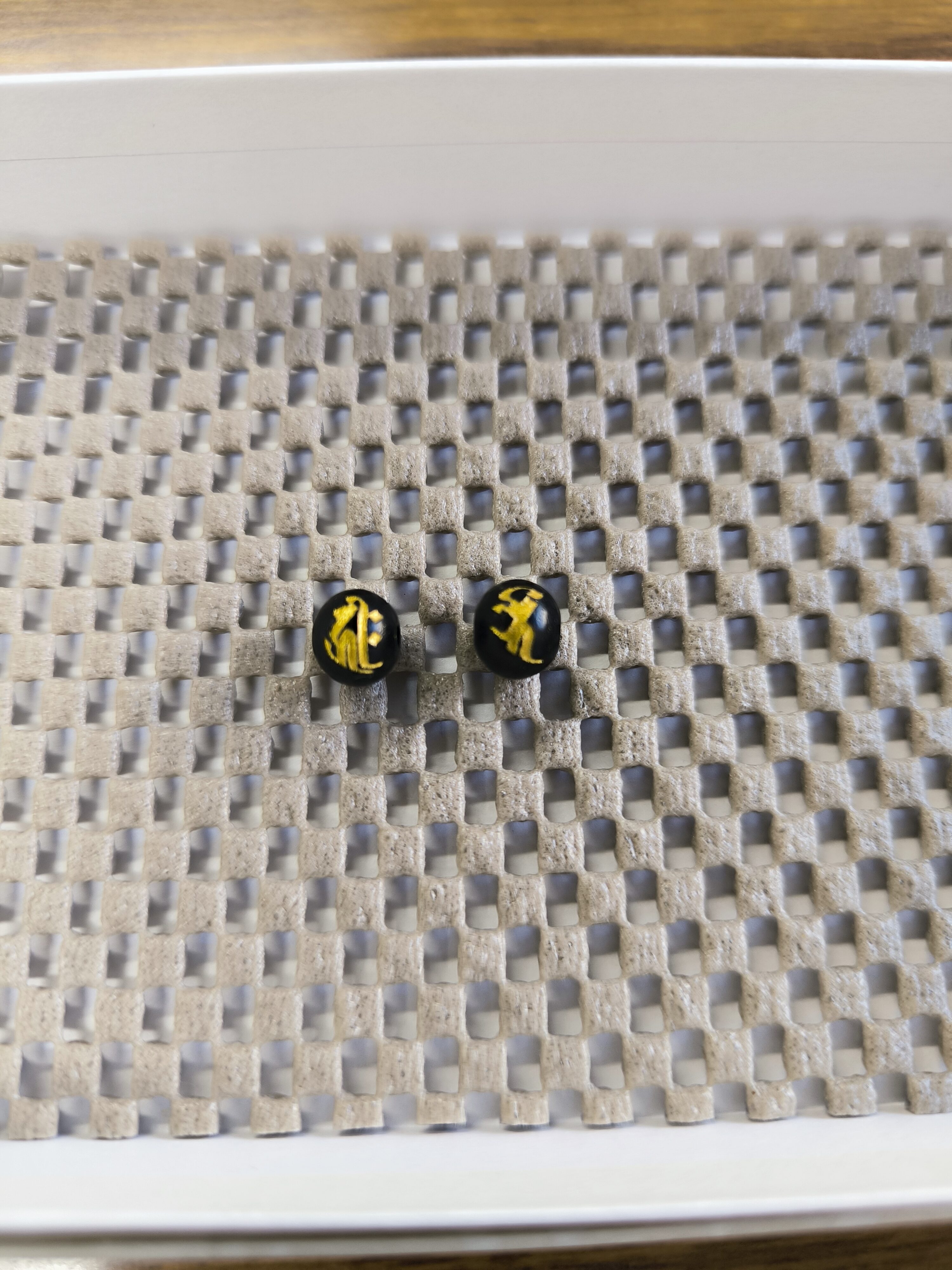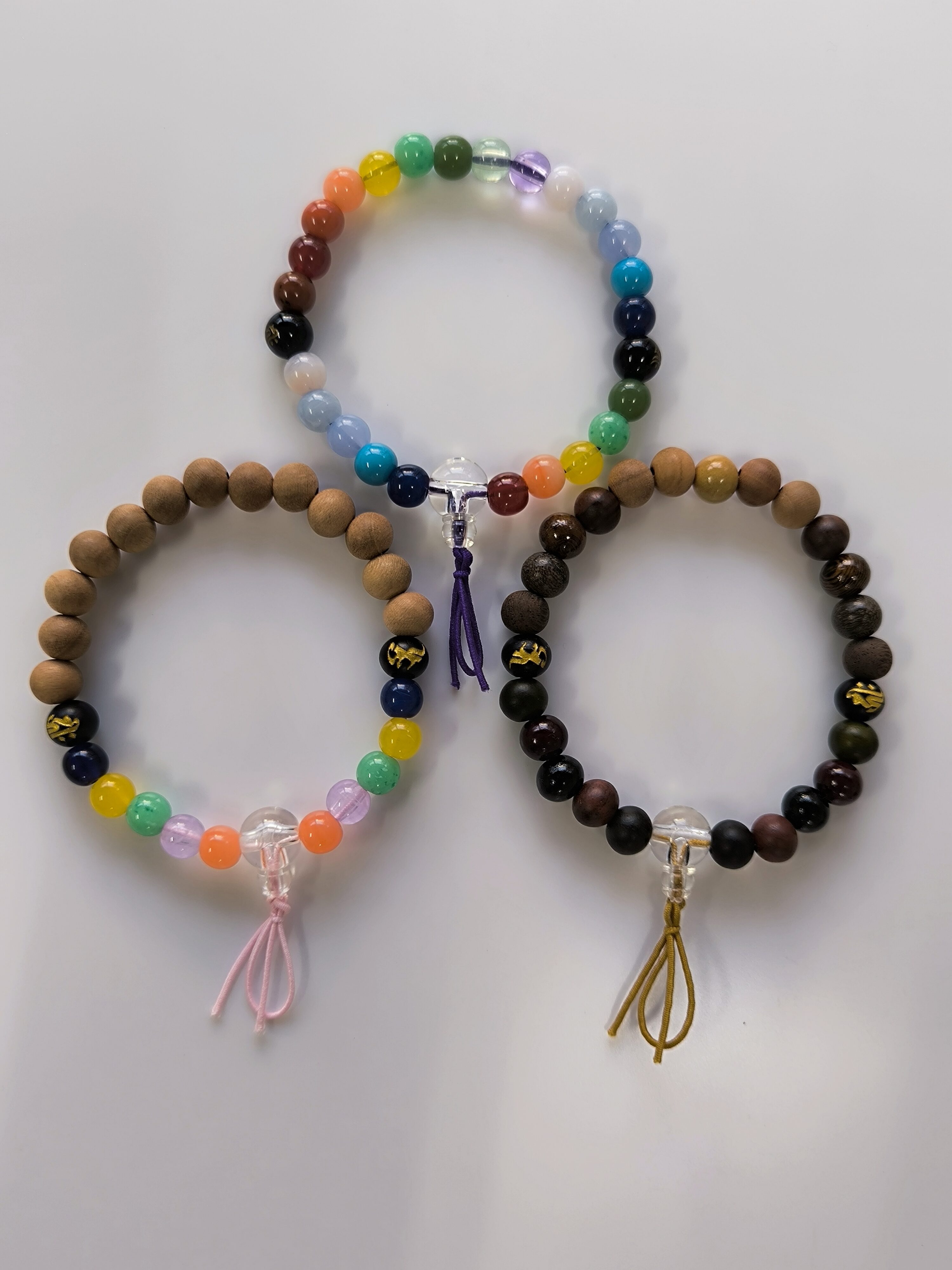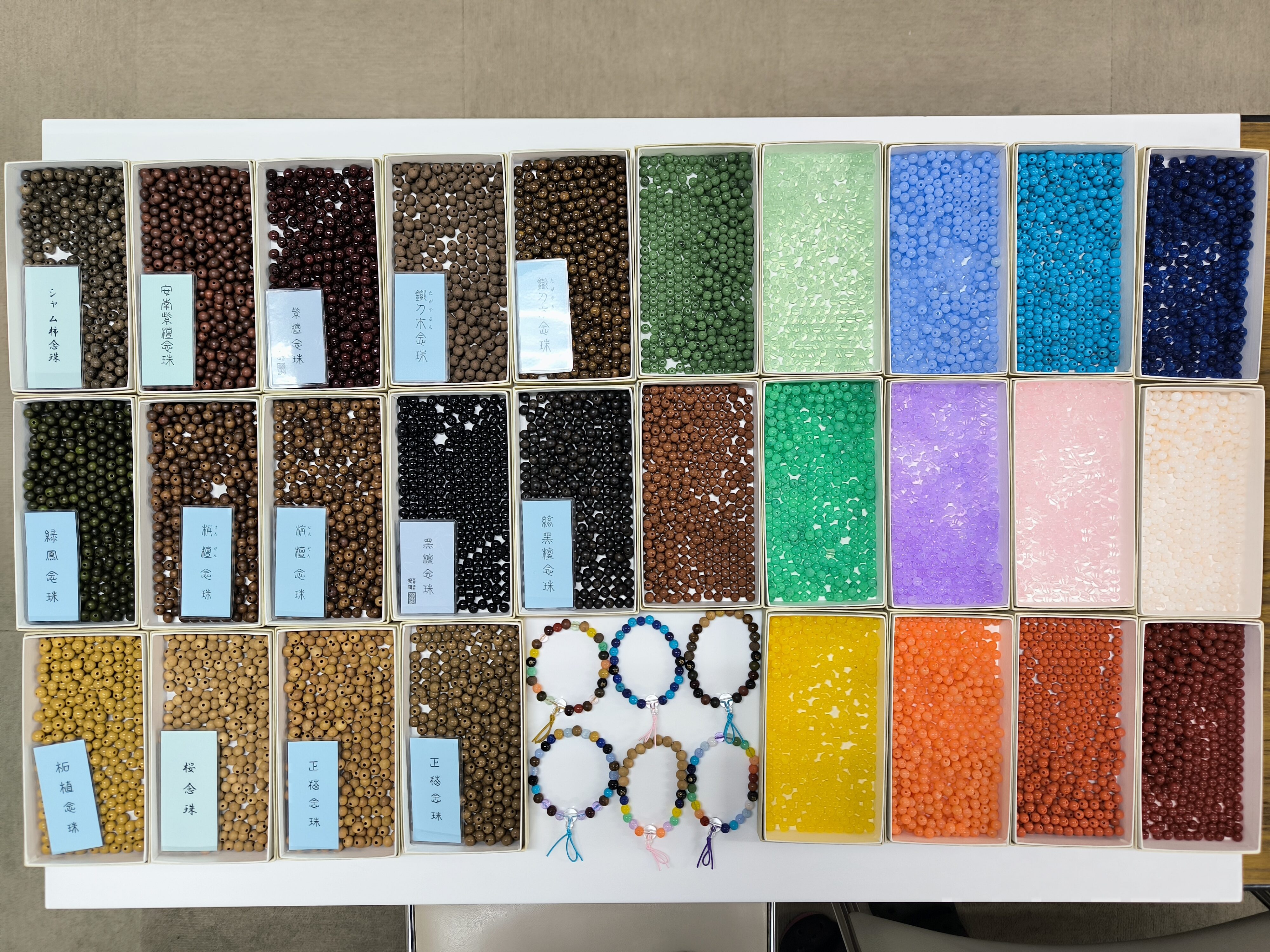







【10/25,26 数珠作りワークショップ】
Juzu (Buddhist Prayer Bead) Making Workshop
約50種類の玉の中から自由にデザイン。あなただけのオリジナル御守りブレスを作ってみませんか?
Design your own unique charm bracelet by freely choosing from about 50 types of beads. Create a one-of-a-kind omamori accessory just for you!
開催情報
Event Details
開催日時 / Date & Time
2025年10月25日(土)、26日(日) 12:00〜17:00
開催場所 / Venue
京都駅 駅前広場特設テント /
参加費 / Admission
3,300円(税込)
参加方法 / Registration
WEBからの事前申込または会場で直接申し込み
【事前申込はこちら】
https://peatix.com/event/4597253
概要
Overview
仁和寺様より、ご提供頂いた梵字を黒檀に彫刻しました。
約50種類(天然木20種、彩りのPC30種)の玉の中から、自由にデザイン。梵字を二個両サイドに入れて、あなただけの御守りブレスをお作りいただきます。
念珠職人二名、優しく丁寧を念頭に。小さなお子様(3歳~)も体験いただけます。
Sacred Sanskrit characters provided by Ninna-ji Temple are engraved on ebony beads.
Choose freely from about 50 types of beads—including 20 kinds of natural wood and 30 colorful PC beads—to design your own bracelet. Two engraved beads featuring Sanskrit characters will be placed on each side, creating a personalized omamori (protective) bracelet just for you.
Guided gently and carefully by two experienced Buddhist prayer bead artisans, the workshop is open to participants as young as three years old.
協力 / Special Cooperation
株式会社安田念珠店
安田念珠店は天和3年(江戸初期)、数珠の専門店として
京都寺町六角に創業いたしました。
以来十代を数える屈指の老舗メーカーとして、
人の心にぬくもりを伝える丁寧なお数珠をつくり続けています。
変わり続ける世の中で、変わらないものを見つめること。
お数珠は日本人のこころに根ざした美しいお道具です。
決して、法事やお葬式のためだけのものではありません。
想いを込めて念じる、だから「お念珠」。
傷んでもお修理をして、ずっと大切にして頂きたいから。
質の良い本物だけを届けたい。
お念珠ひとすじ、三百三十余年。
今も昔も変わらない、私たちの答えです。
Founded in Tenna 3 (1683) during the early Edo period, Yasuda Nenjuten began as a specialty shop for Buddhist prayer beads (juzu) in Rokkaku, Teramachi, Kyoto.
For over ten generations, we have continued to craft each bead with care and sincerity, delivering warmth and comfort to the hearts of those who hold them.
In a world that is constantly changing, we remain devoted to what is unchanging.
A juzu is a beautiful, deeply rooted expression of the Japanese spirit—
not merely an item for memorial services or funerals,
but a sacred tool for heartfelt reflection and prayer.
We hope each nenju will be cherished for a lifetime—
repaired and restored when needed, and always treasured.
That is why we deliver only genuine, high-quality pieces.
Over 330 years dedicated solely to prayer beads—
our enduring answer, unchanged through time.
総本山 仁和寺
真言宗御室派総本山。886年(仁和2)、光孝天皇の勅願により創建、888年(仁和4)に完成。年号を寺名とした。宇多天皇が落髪入寺し寺内に御室(御座所)を設け、御室御所とも呼ばれた。以後、明治維新まで代々皇子皇孫が門跡となり門跡寺院の筆頭にあった。堂塔伽藍は応仁の乱(1467-77)で多くを焼失、寛永・正保年間(1624-48)に再興した。金堂(国宝)は御所紫宸殿を移築。御影堂(重文)も旧清涼殿の材を用いて建立した。霊宝館には、阿弥陀三尊像(国宝)、御室相承記(国宝)、吉祥天立像(重文)など多くの寺宝を所蔵。遅咲きの‘御室桜’は有名で名勝。旧御室御所御殿の御所風たたずまい、豪華な襖絵が見事。1994年(平成6)12月「古都京都の文化財」として、「世界遺産条約」に基づく世界文化遺産に登録された。
Head Temple of the Omuro School of Shingon Buddhism
Founded in 886 (Ninna 2) by imperial decree of Emperor Kōkō and completed in 888 (Ninna 4), Ninna-ji Temple takes its name from the era in which it was established.
When Emperor Uda took Buddhist vows and entered the temple, he built a residence within the grounds known as the Omuro, leading to the temple’s other name, Omuro Gosho (“Imperial Residence of Omuro”).
From that time until the Meiji Restoration, successive members of the imperial family served as head priests, making Ninna-ji the foremost among monzeki temples (temples traditionally headed by imperial princes).
Much of the temple complex was lost during the Ōnin War (1467–1477), but it was rebuilt in the Kan’ei and Shōhō eras (1624–1648).
The Golden Hall (Kondō), now a National Treasure, was relocated from the Shishinden (Hall for State Ceremonies) of the Kyoto Imperial Palace.
The Miei-dō Hall (Important Cultural Property) was built using materials from the former Seiryōden.
The Reihōkan (Treasure Hall) houses many cultural treasures, including the Amida Triad (National Treasure), the Omuro Sōjōki (National Treasure), and the Standing Statue of Kisshōten (Important Cultural Property).
The temple is also famous for its late-blooming Omuro-zakura cherry trees, designated as a Place of Scenic Beauty.
With its graceful palace-style architecture and magnificent fusuma (sliding door) paintings, Ninna-ji preserves the refined elegance of an imperial residence.
In December 1994, it was inscribed as part of the UNESCO World Heritage Site “Historic Monuments of Ancient Kyoto.”